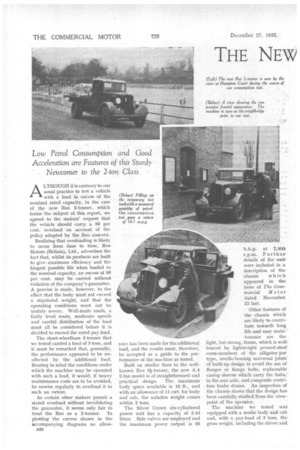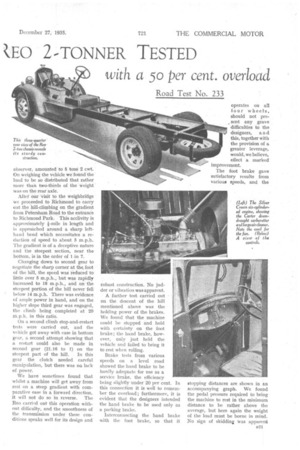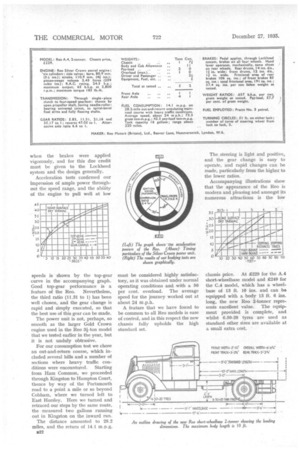THE NEW E0 2 TONI\ ER TESTED
Page 26

Page 27

Page 28

If you've noticed an error in this article please click here to report it so we can fix it.
with a 50 per cent. overload
ALTHOUGH it is contrary to our usual practice to test a vehicle with a load in excess of the nominal rated capacity, in the case of the new Reo 2-tonner, which forms the subject of this report, we agreed to the makers' request that the vehicle should carry a 50 per cent. overload on account of the policy adopted by the Reo concern.
Realizing that overloading is likely to occur from time to time, Reo Motors (Britain), Ltd., advertises the fact that, whilst its products are built to give maximum efficiency and the longest possible life when loaded to the nominal capacity, an excess of 50 per cent. may be carried without violation of the company's guarantee. A proviso is made, however, to the effect that the body must not exceed a stipulated weight, and that the operating conditions must not be unduly severe. Well-made roads, a fairly level route, moderate speeds and careful distribution of the load must all be considered before it is decided to exceed. the rated pay-load.
The short-wheelbase 2-tonner that we tested carried a load of 3 tons, and it must be remarked that, generally, the performance appeared to be unaffected by the additional load. Bearing in mind the conditions under which the machine may be operated with such a load, it would, if heavy maintenance costs are to be avoided, be unwise regularly to overload it to such an extent, As certain other makers permit a stated overload without invalidating the guarantee, it seems only fair to treat the Reo as a 2-tonner. In plotting the curves shown in the accompanying diagrams no allow B20 ance has been made for the additional load, and the results must, therefore, be accepted as a guide to the performance of the machine as tested.
Built on similar lines to the wellknown Reo 3i-toriner, the new A.4 2-ton model is of straightforward and practical design. The maximum body space available is 10 ft., and with an allowance of 11 cwt, for body and cab, the unladen weight comes within 2 tons.
The Silver Crown six-cylimiered power unit has a capacity of 3.43 litres. Side valves are employed and the maximum power output is 65
b.h.p. at 2,800 r.p.m. Further, details of the unit' were included in a description of the chassis which appeared in .the issue of The Commercial Mot or dated November 22 last.
Other features of the chassis which are likely to contribute towards long life and easy maintenance are the light, but strong, frame, which is Well: braced by lightweight pressed-steer. cross-members of the alligator-jaw type, needle-bearing universal joints ' of built-up design to avoid the use of flanges or flange bolts, replaceable' casing sleeves which carry the hubs,' in the rear axle, and composite centrifuse brake drums. An inspection of the chassis shows that the design has been carefully studied from the viewpoint of the operator.
The machine we tested with. equipped with a works body and cab and, with a pay-load Of 3 tons, the gross weight, including the driver and
observer, amounted to 5 tons 2 cwt. On weighing the vehicle we found the load to be so 'distributed that rather more than two-thirds of the weight was on the rear axle.
After our visit to the weighbridge we proceeded to Richmond to carry out the hill-climbing on the gradient from Petersham Road to the entrance to Richmond Park. This acclivity is approximately f-mile in length and is approached around a sharp lefthand bend which necessitates a reduction of speed to about 5 m.p.h. The gradient is of a deceptive nature and the steepest section, near the bottom, is in the order of 1 in 7.
Changing down to second gear to negotiate the sharp corner at the foot of the hill, the speed was reduced to little over 5 m.p.h., but was rapidly increased to 18 m.p.h., and on the steepest portion of the hill never fell below 14 m.p.h. There was evidence of ample power in hand, and on the higher slope third gear was engaged, the climb being completed at 20 m.p.h. in this ratio.
On a second climb stop-and-restart tests were carried out, and the vehicle got away with ease in bottom gear, a second attempt showing that a restart could also be made in second gear (21.16 to 1) on the steepest part of the hill. In this gear the clutch needed careful manipulation, but there was no lack of power.
We have sometimes found that whilst a machine will get away from rest on a steep gradient with comparative ease in a forward direction, it will not do so in reverse. The Reo carried out this operation without difficulty, and the smoothness of the transmission under these conditions speaks well for its design and robust construction. No judder or vibra lion was apparent.
A farther test. carried out on the descent of the hill mentioned above was the holding power of the brakes. We found that the machine could be stopped and held with certainty on the foot brake; the hand brake, however, only just held the vehicle and failed to bring it to rest when rolling.
Brake tests from various speeds on a level road showed the hand brake to be hardly adequate for use as a service brake, the efficiency being slightly under 20 per cent. In this connection it is well to remember the overload; furthermore, it is evident that the designers intended the hand brake to be used only as a parking brake.
Interconnecting the hand brake with the foot brake, so that it operates on all four wheels, should not present any grave difficulties to the designers, and this, together with the provision of a greater leverage, would, we believe, effect a marked improvement.
The foot brake gave satisfactory results from various speeds, and the
stopping distances are shown in an accompanying graph. We found the pedal pressure required to bring the machine to rest in the minimum distance to be rather above the average, but here again the weight of the load must be borne in mind. No sign of skidding was apparent
when the brakes were applied vigorously, and for this due credit must be given to the Lockheed system and the design generally.
Acceleration tests confirmed our impression of ample power throughout the speed range, and the ability of the engine to pull well at low speeds is shown by the top-gear curve in the accompanying graph. Good top-gear performance is a feature of the Reo. Nevertheless, the third ratio (11.31 to 1) has been well chosen, and the gear change is rapid and simply executed, so that the best use of this gear can be made.
The power unit is not, perhaps, so smooth as the larger Gold Crown engine used in the Reo 3i-ton model that we tested earlier in the year, but it is not unduly obtrusive.
For our consumption test we chose an out-and-return course, which included several hills and a number of sections where heavy traffic conditions were encountered. Starting from Ham Common, we proceeded through Kingston to Hampton Court, thence by way of the Portsmouth road to a point a mile or so beyond Cobham, where we turned left to East Horsley. Here we turned and retraced our steps by the same route, the measured two gallons running out in Kingston on the inward run.
The distance amounted to 28.2 miles, and the return of 14.1 m.p.g. must be considered highly satisfactory, as it was obtained under normal operating conditions and with a 50 per cent, overload. The average speed for the journey worked out at about 24 m.p.h.
A feature that we have found to be common to all Reo models is ease of control, and in this respect the new chassis fully upholds the high standard set. The steering is light and positive, and the gear change is easy to operate, and rapid changes can be made, particularly from the higher to the lower ratios.
Accompanying illustrations show that the appearance of the Reo is modern and pleasing and amongst its numerous attractions is the low chassis price. At £229 for the A.4 short-wheelbase model and £249 for the C.4 model, which has a wheelbase of 13 ft. 10 ins, and can be equipped with a body 13 ft. 6 ins. long, the new Reo 2-tonner represents excellent value. The equipment provided is complete, and whilst 6.50-20 tyres are used as standard other sizes are available at a small extra cost.












































































